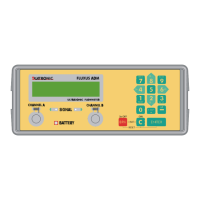
Do you have a question about the Katronic Technologies FLUXUS ADM 6725 and is the answer not in the manual?
| Brand | Katronic Technologies |
|---|---|
| Model | FLUXUS ADM 6725 |
| Category | Measuring Instruments |
| Language | English |
Explains the ultrasonic transit time method for measuring liquid flow.
Covers powering the instrument on/off and navigating the main menu.
Details powering the instrument on/off and accessing the MAIN MENU.
Details the instrument's power options, including battery and external power.
Details recommended pipe lengths upstream and downstream of disturbance sources.
Covers inputting pipe parameters like diameter, thickness, material, and lining.
Describes how to input pipe outside diameter and circumference data.
Explains how to input the pipe wall thickness and its relation to transducer characteristics.
Details the selection of pipe material and its impact on sound velocity.
Covers the input of medium properties like sound velocity, viscosity, density, and temperature.
Covers confirming transducer type and entering parameters for special versions.
Covers preparing for measurement, including channel activation and transducer positioning.
Explains how to identify and input the measuring point details.
Explains the choice between diagonal and reflection transducer mounting methods.
Details the steps for mounting transducers using the reflection method.
Explains the procedure for mounting transducers using the diagonal method.
Describes how to determine and set the correct transducer distance.
Provides methods for mounting transducers using chains or tension straps.
Guides on adjusting transducer position for maximum signal strength.
Details starting the measurement process and operational modes (AUTO-MUX, MANUAL-MUX).
Identifies measurement disturbances and suggests corrective actions.
Guides on selecting the desired measurement quantity and its unit.
Details how to enable and configure the internal data logger for storing measurements.
Explains how to output measured data online or offline via a serial interface.
Explains how to create, save, and manage parameter records for measurement tasks.
Details the process of saving the current instrument settings as a parameter record.
Explains how to retrieve and select previously stored parameter records.
Explains the MOVEFAST utility for transferring stored data to a PC.
Explains how to activate and deactivate the Super User Mode using a HotCode.
Highlights key characteristics and implications of operating in Super User Mode.
Guides on selecting the sound path for measurement, affecting transducer mounting.
Covers editing transducer parameters when in Super User Mode.
Discusses potential malfunctions and issues that can occur in Super User Mode.
Guides on setting up parameters and functions for virtual calculation channels.
Explains how to perform measurements using activated virtual calculation channels.
Introduces the HQM option for measuring heat quantity using temperature and flow data.
Explains how the MEASURING branch is extended for heat quantity measurements.
Introduces the WTM option for operating FLUXUS as a wall thickness gauge.
Details the process of measuring wall thickness and obtaining valid values.
Explains how to measure the sound velocity of a material using the probe.
Provides an overview of error messages encountered during operation.
Provides guidance for troubleshooting measurement issues and deviations.
Lists checks for when a measurement is not successful and the signal LED is red.
Offers checks for when measurements do not match expected values.